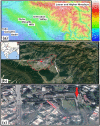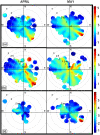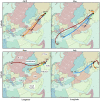Characteristics of equivalent black carbon aerosols over Doon Valley in NW Indian Himalaya during COVID-19 lockdown 2020
- PMID: 35220495
- PMCID: PMC8882040
- DOI: 10.1007/s10661-022-09879-9
Characteristics of equivalent black carbon aerosols over Doon Valley in NW Indian Himalaya during COVID-19 lockdown 2020
Abstract
Recently, black carbon (BC) has been identified as a potential transmitter for COVID-19 besides being responsible for climate change and serious health hazards. To mitigate the dreaded consequences of COVID-19 pandemic, the Government of India declared a nationwide lockdown on March 24, 2020. Accordingly, observations on equivalent black carbon (EBC) aerosols using AE 51 Aethalometer were performed during different lockdowns in Doon Valley. During April, May, June, and July, the monthly average EBC mass concentration recorded 2.12 ± 1.14 μg m-3, 2.58 ± 1.46 μg m-3, 2.74 ± 1.49 μg m-3, and 2.12 ± 1.32 μg m-3, respectively. A comparison of diurnal variation patterns with earlier studies indicates a significant reduction in EBC mass concentration levels. Bipolar NWR analysis for April and May depicts that relatively high EBC concentration was experienced with prominent south-easterly winds. The EBC concentration level during daytime was high compared to nighttime hours. Preliminary visualization of scanning electron micrographs indicates the variable morphology of aerosols. The bulk particle EDX spectral analysis indicates C, O, Na, F, Al, Si, K, Ca, and Ti elements with a dominance of C and O. Windblown dust seems to be the major contributor to the ambient aerosols. Furthermore, MODIS recorded the fire anomaly (attributed to the wheat stubble burning) starting from mid of April to early-June along the Indo-Gangetic Basin. Heavy loading of polluted aerosols was visible in CALIPSO data imageries. HYSPLIT cluster trajectories indicate that the study region is strongly influenced by the air mass transporting from the Gangetic Plain, Iran, Pakistan, Afghanistan, and Gulf region.
Keywords: Air pollution; Black carbon; CALIPSO; COVID-19 lockdown; HYSPLIT; Himalaya; MODIS.
© 2022. The Author(s), under exclusive licence to Springer Nature Switzerland AG.
Conflict of interest statement
The authors declare no competing interests.
Figures








Similar articles
-
Variations in Black Carbon concentration and sources during COVID-19 lockdown in Delhi.Chemosphere. 2021 May;270:129435. doi: 10.1016/j.chemosphere.2020.129435. Epub 2020 Dec 26. Chemosphere. 2021. PMID: 33412356 Free PMC article.
-
Black carbon pollutants in pristine Himalayan ecosystem: a pilot study along Gangotri Glacier Valley.Environ Monit Assess. 2021 Oct 16;193(11):726. doi: 10.1007/s10661-021-09482-4. Environ Monit Assess. 2021. PMID: 34655335
-
Variation in chemical composition and sources of PM2.5 during the COVID-19 lockdown in Delhi.Environ Int. 2021 Aug;153:106541. doi: 10.1016/j.envint.2021.106541. Epub 2021 Apr 9. Environ Int. 2021. PMID: 33845290
-
COVID-19-associated 2020 lockdown: a study on atmospheric black carbon fall impact on human health.Environ Geochem Health. 2023 Jun;45(6):3507-3520. doi: 10.1007/s10653-022-01430-6. Epub 2022 Nov 11. Environ Geochem Health. 2023. PMID: 36367602 Free PMC article.
-
[Evolution and Potential Source Apportionment of Atmospheric Pollutants of Two Heavy Haze Episodes During the COVID-19 Lockdown in Beijing, China].Huan Jing Ke Xue. 2021 Nov 8;42(11):5109-5121. doi: 10.13227/j.hjkx.202104289. Huan Jing Ke Xue. 2021. PMID: 34708950 Chinese.
References
-
- Bachmann, J. (2009). Black carbon: A science/policy primer. Pew Center on Global Climate Change Black 45.
-
- Bhat PA, Shafiq M, ul, Mir, A.A., Ahmed, P., Urban sprawl and its impact on landuse/land cover dynamics of Dehradun City, India. International Journal of Sustainable Built Environment. 2017;6:513–521. doi: 10.1016/j.ijsbe.2017.10.003. - DOI
-
- Bond TC, Anderson TL, Campbell D. Calibration and intercomparison of filter-based measurements of visible light absorption by aerosols. Aerosol Science and Technology. 1999;30:582–600. doi: 10.1080/027868299304435. - DOI
-
- Bond TC, Doherty SJ, Fahey DW, Forster PM, Berntsen T, Deangelo BJ, Flanner MG, Ghan S, Kärcher B, Koch D, Kinne S, Kondo Y, Quinn PK, Sarofim MC, Schultz MG, Schulz M, Venkataraman C, Zhang H, Zhang S, Bellouin N, Guttikunda SK, Hopke PK, Jacobson MZ, Kaiser JW, Klimont Z, Lohmann U, Schwarz JP, Shindell D, Storelvmo T, Warren SG, Zender CS. Bounding the role of black carbon in the climate system: A scientific assessment. Journal of Geophysical Research Atmospheres. 2013;118:5380–5552. doi: 10.1002/jgrd.50171. - DOI
MeSH terms
Substances
LinkOut - more resources
Full Text Sources
Medical
Research Materials
Miscellaneous

